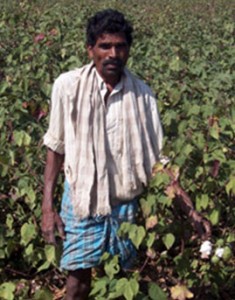THIRD WORLD NETWORK BIOSAFETY INFORMATION SERVICE
Press Release
Coalition for a GM-free India, India
21 March 2012
(http://indiagminfo.org/?p=393#more-393)
The false hype and failed promises of Bt cotton in India were exposed by the Coalition for GM-Free India with a special report released in a press conference here today. As the 10th anniversary of Bt cotton’s regulatory approval in India approaches, the Coalition, using data
from government institutions, highlighted that the hype around Bt cotton as revolutionizing the cotton production in India is clearly
wrong. Closer examination of the data from the last 10 years negates the two important claims of dramatic yield increase and significant
fall in pesticide usage. The report clearly exposes the dark side of the Bt cotton story – stagnant yields, pest resistance, new pest and
disease attacks, the need for high levels of expensive farm inputs and the spate of tragic farmer suicides in the cotton belt.
In the face of aggressive PR campaign by the biotechnology industry which is being uncritically accepted by the government and regulators, the Coalition said, “This is a wake-up call for the Government, Parliamentarians, policy-makers, farmer organizations and media to closely examine the crisis in the cotton belt and critically re-assess the 10 years of Bt cotton. The government should stop promoting Bt cotton and pro-actively advise farmers about its unsuitability and risks.”
The cotton farmers are in deep crisis after ten years of Bt cotton. The spate of farmer suicides in 2011-12 has been particularly severe
among Bt cotton farmers. The extensive crop failure has exposed the false hype and advertising, often repeated by policymakers and
regulators. In Andhra Pradesh, state government estimates show that out of 47 lakh acres planted with Bt cotton during Kharif 2011 season, the crop failed in 33.73 lakh acres (71% of the area). The state government reported that 20.46 lakh farmers suffered from cotton crop failure and lost Rs.3071.6 cr. In Maharasthra, the cotton crisis forced the government to take the unprecedented step of declaring Rs. 2000 cr. as compensation (the estimated loss is Rs.10,000 cr.). The cotton production estimates had to be downgraded despite the large expansion in cotton cultivation area.
Presenting some of the analysis, Kiran Vissa, co-convener of the Alliance for Sustainable and Holistic Agriculture (ASHA) said, “The
real yield gains in the past decade (from 278 kg/ha to 470 kg/ha) happened from 2000-01 to 2004-05, i.e. when Bt cotton area reached
only 5.6% of the total cotton area. From 2005-06 to 2011-12, when the Bt cotton area grew to exceed 90% of the total cotton area, there is
no sustained yield gain – only going from 470 kg/ha to 481 kg/ha. It is the pre-Bt cotton yield gains that have proved to be stable,
resulting from various factors including fresh land brought under cotton cultivation, expansion of irrigation and use of high-yielding
hybrids.” The report also refers to the statement of Dr. K.R. Kranthi, Director of Central Institute for Cotton Research(CICR), “The main
issue that worries stakeholders is the stagnation of productivity at an average of 500 kg lint per ha for the past seven years. The gains
have been stagnant and unaffected by the increase in area of Bt cotton from 5.6% in 2004 to 85% in 2010.”
Regarding pest protection, scientific studies and the company statements show that the target pest bollworm has developed tolerance
to Bt cotton, whereas secondary pests like mealy bugs and whiteflies which were hitherto unseen are causing major damage. At the farmer level, pesticide spraying quickly went back to pre-Bt levels after the first three years. Data from Directorate of Plant Protection for six major cotton-growing states shows that in Maharashtra with the largest Bt cotton cultivation area, there has been a steep increase in
pesticide volume (3198 MT in 2005-06 to 4639 MT in 2009-10) whereas in four other states (Gujarat, M.P., Punjab, Karnataka) there is a marginal increase. The only decline is in A.P., possibly due to the successful campaign against pesticide use by the government’s
Non-Pesticidal Management (NPM) program. At the national level, even in the peak expansion years of Bt cotton, the pesticide usage
increased by 10%. This is despite the heavy increase in use of more powerful low-volume pesticides during the same period, which should
have reduced the total volumes. This shows that Bt technology is a false solution to the pesticide problem ˆ the NPM methods which
eliminate pesticide usage completely have been successfully demonstrated in states like A.P. in large-scale government programs
while the Bt technology with all its risks, at best reduces pesticide usage temporarily for a given target pest.
Official information shows that Bt cotton requires more inputs in terms of fertilizers and irrigation, and is particularly susceptible
to rainfall shortage at peak bolling period. The costs of cultivation have gone up significantly after the introduction of Bt cotton,
leading to increased risk and debt for small farmers. The Coalition’s report also criticizes the false and unethical advertising by the
companies like Mahyco-Monsanto whose advertisements were pulled up by Advertising Standards Council of India, earlier this year.
Kishor Tiwari of the Vidarbha Jan Andolan Samiti which has been campaigning for several years on farmer suicides and agrarian crisis
in Vidarbha said, “The fact is that the crisis of cotton farmers in Maharashtra has only become deeper after the adoption of Bt cotton.
This year, we estimate that Bt cotton farmers have lost Rs.10,000 crores due to crop failure. Even the government compensation of
Rs.2000 crores is quite small considering the loss. It is an irony that the state government is compensating for the failure of private
company seeds. Maharashtra tops the nation in farmer suicides, with 3181 in 2010, and the number is likely to be worse in 2011. Though
studies have shown that Bt cotton is not suitable for rain-fed regions which form majority of the cotton cultivation area, it is promoted
aggressively with farmers through misleading advertising. Even the government institutions do not have non-Bt seed available for the
farmers. We exposed the false media campaigns of the companies regarding Bhamraja and other villages, and the ground situation in
Yavatmal district was also witnessed by the Parliamentary Standing Committee on Agriculture recently.”
Vijay Pratap of the Kisan Swaraj Sampark Kendra added that said, “We are asking farmers around the country to be aware of the dangers of the technology and the manipulations and monopolistic control of these corporations. Farmers who were frustrated with one unsustainable technology of chemical pesticides were asked to adopt another unsustainable technology promoted by the same companies which sold the pesticides. The Bt cotton story also cautions us about the false hype around other Genetically Modified crops being pushed as inevitable, and the bull-dozing of the technology through legal frameworks such as Biotechnology Regulatory Authority of India (BRAI) Bill. We will continue to push for food security and sovereignty, sustainable farmer livelihoods, and democratic decision-making on science & technology”.
Sridhar Radhakrishnan, Convener of the Coalition for a GM-Free India demanded, “The government, political parties and scientists should reject the false hype, and perform a comprehensive, independent and participatory review of 10 years of Bt cotton. The Parliament should have a special discussion on cotton farmers‚ crisis and 10 years of Bt cotton. Government agencies should stop promoting Bt cotton, and rejuvenate the non-Bt seed production to make it available for farmers. Strict action should be taken against false claims and advertising by the companies. It is shameful that while the Indian farmer is reeling under the crisis and Bt Cotton faced its worst failure, the recent State of Indian Agriculture report talks of Bt Cotton as an unqualified success and promotes GM technology as a magic bullet.”
Coalition for a GM-Free India is a broad national network of organizations, scientists, farmer unions and consumer groups. Website:
www.indiagminfo.org
The report “10 Years of Bt Cotton: False Hype and Failed Promises Cotton farmers’ crisis continues with crop failure and suicides” is
available at: http://indiagminfo.org/wp-content/uploads/2012/03/Bt-Cotton-False-Hype-and-Failed-Promises-Final.pdf
Wish without action is waste of time
Gebremedhin Birega Dagaga
Director, ETHIOSCOP

